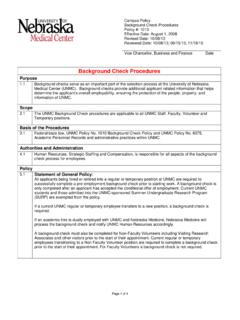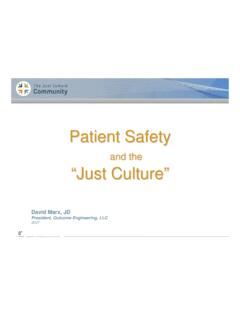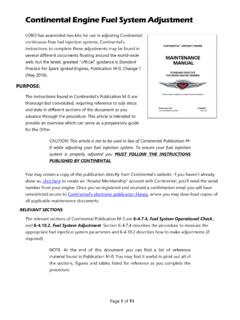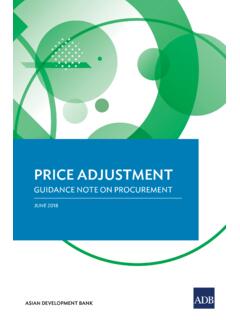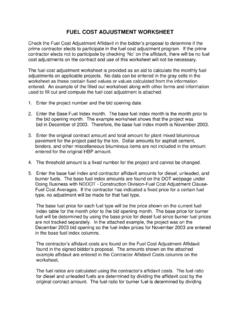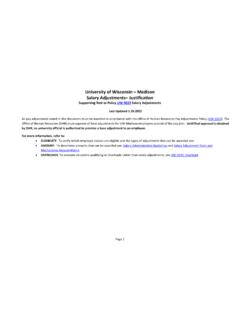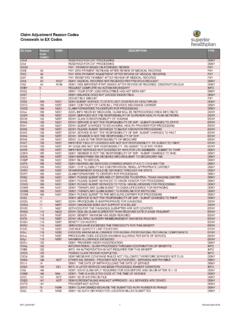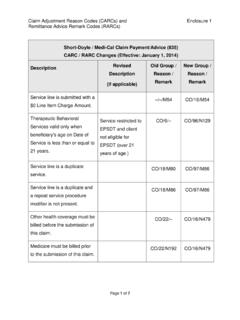Transcription of Renal Dose Adjustment Guidelines for Antimicrobials CRRT ...
1 Renal Dose Adjustment Guidelines for Antimicrobials CRRT Dosing Recommendations CRRT Background: When a patient is initiated on CRRT, antimicrobial therapy often requires Adjustment to ensure adequate drug concentrations are achieved. CVVHD removes solutes (including drugs) via diffusion. An electrolyte solution (dialysate) runs countercurrent to the patient s blood flow which creates a concentration gradient, driving the removal of solutes. o Drug removal is impacted by protein binding ( highly protein bound drugs will be minimally removed) and rate of dialysate flow (increased removal with higher flow rates). o Drugs that are renally cleared or removed by hemodialysis are likely to be impacted by CVVHD.
2 CVVH removes solutes (including drugs) via convection. Convection is a transport mechanism that is accomplished by using a high-permeability membrane to generate a large ultrafiltrate volume. Along with the ultrafiltrate, plasma water and certain solutes are forced across the membrane. Important Considerations: In patients with Renal failure, the time to achievement of steady-state is increased for renally-eliminated agents. Additionally, patients on CRRT frequently have an increased volume of distribution. Therefore, a loading dose should be utilized if not initiating therapy at the full dose. Patients undergoing CRRT may be predisposed to changes in pharmaceutical agents volume of distributions (Vd).
3 When agents with relatively large therapeutic windows ( beta-lactams) and low levels of toxicity are utilized in critically ill patients, it may be prudent to err on the side of more aggressive dosing to account for any increases in (Vd). While on CRRT, patients residual Renal function may continue to change. Improvements or reductions in residual Renal function may warrant a change in dosing strategy. Residual Renal function should be evaluated on a daily basis when making CRRT dosing plans. Monitor patients for interruption of CRRT ( clotting) or changing filtration rates. When CRRT is off, dose as hemodialysis patients or based on any residual Renal function.
4 The recommendations below should be used as a guide to aid in antibiotic dosing while on CRRT. Dosing regimens should be tailored based on presumed source of infection, MIC data (when available), and residual Renal function. When a dosing range is indicated in the tables below ( , ampicillin/sulbactam g q6-8h), a more aggressive dose should be selected for severe infections. Pharmacists should document final dosing recommendations and any necessary rationale using the preformatted note available in One Chart. The following anti-infectives do NOT require dose Adjustment during CRRT: Amphotericin Azithromycin Ceftriaxone Clindamycin Doxycycline Linezolid Metronidazole Micafungin Oxacillin Rifampin Tigecycline Voriconazole Table 1.
5 CVVHD Dosing Recommendations Drug Loading Dose for CRRT Standard Anephric Dose Dose by CVVHD Dialysate Flow Rate Ref. 1 L/h 2 L/h 3-4 L/h Aminoglycosides Provide loading dose then dose per TDM Provide loading dose then dose per TDM; patients may require repeat dosing q24h at flow rates >1 L/h 1, 2 Amikacin 10 mg/kg Gentamicin 3 mg/kg Tobramycin 3 mg/kg Acyclovira NA mg/kg q24h mg/kg q24h 5-10 mg/kg q24h 5-10 mg/kg q12hb 1, 2 Ampicillin/sulbactam 3 g g q24h q8h q6-8hb q6hb 1, 2 Aztreonam 2 g 1-2 g q24h 1 g q8h or 2 g q12h 1g q8h or 2 g q12h 2 g q8hb 1 Cefazolin 2 g 1-2 g q24h 1 g q8h or 2 g q12h 1 g q8h or 2 g q12h 2 g q8hb 1 Cefepime (Standard dose) 2 g 1 g q24h 1 g q8h 1 g q6h 2 g q8hb 1, 2, 3, 4, 18 Cefepime (High dose for neutropenic fever)
6 2g 1 g q24h 2g q12h 2g q8h Ceftazidime 2 g 1 g q24h 1 g q8h or 2 g q12h 1 g q8h or 2 g q12h 2 g q8hb 1, 2 Ceftolozane/tazobactamc g 150 mg q8h 375 mg q8h 750 mg q8h q8h 16 Colistin NA 50 mg q12h mg/kg q24h mg/kg q24h 2-3 mg/kg q12h 1, 2, 13, 22, 23 Daptomycin NA 6 mg/kg q48h 4-6 mg/kg q24hr 6 mg/kg q24hr 6-8 mg/kg q24h 1, 2, 5, 6, 19 Ertapenem 1g 500mg IV q24h 1g IV q24h 13 Fluconazoled 800 mg (12 mg/kg) 400 mg (6 mg/kg) after HD three times weekly 400 mg q24h 800 mg q24h 800 mg q24h 800 mg q24h 1, 2, 7 Ganciclovir 5 mg/kg mg/kg after HD three times weekly mg/kg q24h 5 mg/kg q24h or mg/kg q12h 5 mg/kg q12h 1, 12 Levofloxacin 500 mg 250-500 mg q48h 250-750 mg q24h 1, 2, 17 Meropenem (Standard dose) 1-2 g 500-1000 mg q24h 500 mg q8h 500 mg q8h 500 mg q6h 1, 2, 3, 9 Meropenem (High dose for meningitis, cystic fibrosis, or MIC of 4 mcg/mL) 2 g 2g IV q24h 2g q12h 2g q8h Oseltamivir NA If not undergoing HD Not recommended.
7 If undergoing HD 30 mg after every HD cycle 150 mg q12h Piperacillin/tazobactamf EI NA g EI q12h g EI q8h 10, 15 Trimethoprim/sulfamethoxazole (TMP/SMX) 10 mg/kg Severe infections/PJP: mg/kg/day (TMP) divided q12-24h 10 mg/kg/day (TMP) divided q12h 20, 21 Vancomycin 20-25 mg/kg Provide loading dose then dose accordingly to obtain serum concentrations within desired range Provide loading dose then dose patients 10-15 mg/kg q24h and adjust accordingly to obtain serum concentrations within desired range 1, 11 Abbreviations: EI, extended infusion (4 hours); HD, hemodialysis; NA, not applicable; PJP, Pneumocystis jiroveci pneumonia; TDM, therapeutic drug monitoring aUse lower dose for mucocutaneous HSV and higher dose for HSV encephalitis or VZV bFlow rates > 2 L/hr are rarely addressed in literature; decreasing the interval is done empirically to maintain levels above MIC for time-dependent antibiotics, specifically those with limited protein binding cDose adjustments based on data from CVVH since data is lacking for CVVHD dDose assuming invasive candidiasis eDecreased interval is based on data from CVVH since data is lacking for CVVHD and some Antimicrobials .
8 However, CVVHD solute elimination is in general greater than CVVH fTazobactam can accumulate as it is not removed as readily; caution in decreasing interval beyond every 8 hours ( q6h) in patients with lack of residual Renal function Table 2. CVVH Dosing Recommendations Drug Loading Dose for CRRT Standard Anephric Dose Dose by CVVH Dialysate Flow Rate Ref. 1 L/h 2 L/h 3 L/h 4 L/h Aminoglycosides Provide loading dose then dose per TDM Provide loading dose then dose per TDM; patients may require repeat dosing q24h at flow rates >1 L/h 1 Amikacin 10 mg/kg Gentamicin 3 mg/kg Tobramycin 3 mg/kg Acyclovira NA mg/kg q24h mg/kg q24h 5-10 mg/kg q24h 1 Ampicillin/sulbactam g g q24h g q8-12h 1 Aztreonam 2 g 1-2 g q24h 1 g q8h 2g q12h 2 g q8h 2 g q6h 2 Cefazolin 2 g 1-2 g q24h 1 g q12h 1 g q12h 1 g q8h 1 g q8h 2 Cefepime (Standard dose) 2 g 1 g q24h 1 g q8h 1 g q6h 2g q8h 2g q8h 1, 3 Cefepime (High dose for neutropenic fever)
9 2g 1 g q24h 2g q12h 2g q8h Ceftazidime 2 g 1 g q24h 1 g q12h 2g q12h 2 g q8h 2 g q8h 2 Ceftolozane/tazobactamb g 150 mg q8h 375 mg q8h 750 mg q8h q8h 4 Colistin 50 mg q12h mg/kg q48h 1, 8 Daptomycin NA 6 mg/kg q48h No Adjustment necessary; dose as anephric 1 Fluconazolec 800 mg (12 mg/kg) 400 mg (6 mg/kg) after HD three times weekly 200 mg q24h 400 mg q24h 400 mg q12h 400 mg q12h 1, 5 Levofloxacin 500-750 mg 250-500 mg q48h 250 mg q24h 1 Meropenem (Standard dose) 1-2 g 500-1000 mg q24h 500 mg q12h 500 mg q8h 500 mg q6h 500 mg q6h 1, 6 Meropenem (High dose for meningitis, cystic fibrosis, or MIC of 4 mcg/mL) 2 g 2g q24h 2g q12h 2g q8h Piperacillin/tazobactam EI NA g EI q12h g EI q8h 7 Trimethoprim/sulfamethoxazole (TMP/SMX) NA Severe infections/PJP.
10 Mg/kg/day (TMP) divided q12-24h (TMP) q12h 1 Vancomycin 20-25 mg/kg Provide loading dose then dose accordingly to obtain serum concentrations within desired range Provide loading dose then dose patients approximately 500 mg q12h when dialysate flow rates >1 L/h and adjust accordingly to obtain serum concentrations within desired range 6 Abbreviations: EI, extended infusion (4 hours); HD, hemodialysis; NA, not applicable; PJP, Pneumocystis jiroveci pneumonia; TDM, therapeutic drug monitoring aUse lower dose for mucocutaneous HSV and higher dose for HSV encephalitis or VZV b Data limited to dialysate flow rates of 2 L/hr c Dose assuming invasive candidiasis CVVHD References: 1.

